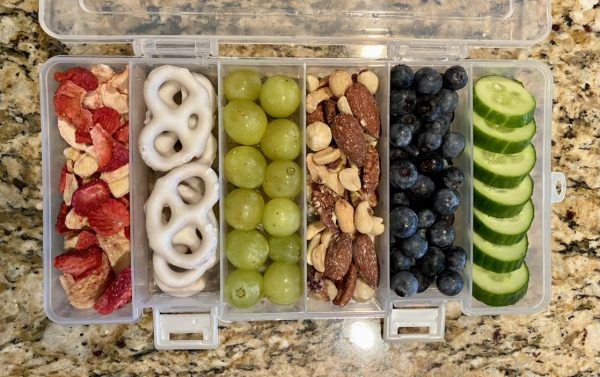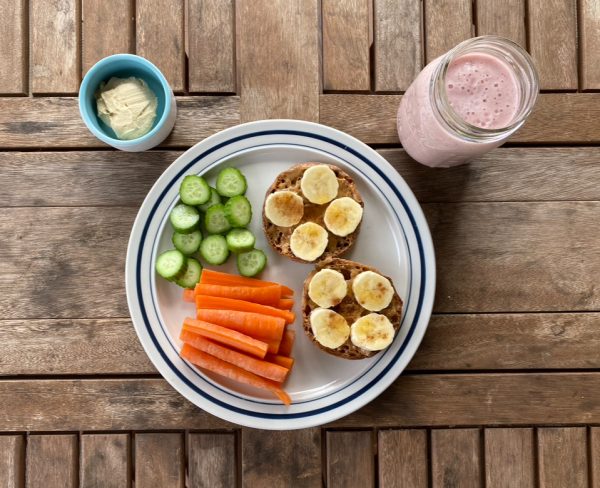For many students, periods can feel like an awkward thing to talk about. However, menstrual cycles are perfectly normal and healthy for anyone with two X chromosomes. In schools, most period education is restricted to a twenty-minute-long presentation in elementary school, with no room for discussion. With a lack of menstrual cycle education, some may think that periods only involve monthly bleeding, when in fact the cycles tend include much more. A major factor influencing how people feel during their menstrual cycles relies on the food they are fueling their week with.
During a menstrual cycle, hormone changes can cause swings in mood, energy, appetite and social engagement. To feel the best during menstrual cycles, it is important to understand the different phases the body goes through. The phases of a menstrual cycle are as follows:
Menstrual phase (days 0 to 7): Period occurs as the uterine lining sheds, estrogen is low causing energy levels to be reduced.
Follicular phase (days 8 to 13): Rising estrogen thickens the uterine lining and boosts energy.
Ovulation phase (days 14 to 15): Ovaries release an egg which peaks estrogen and testosterone, leading to high energy.
Luteal phase (days 16 to 28): Progesterone prepares the uterus to receive a fertilized egg, and PMS symptoms may appear near the end of this phase.
A couple years ago, cycle syncing became a popular idea described as adjusting daily routine around the ‘phases’ of menstrual cycles to improve negative period side effects. While there is some research supporting certain nutrients benefiting menstrual cycle symptoms, adapting people’s lifestyles to fit their menstrual cycle can be unattainable and cause more harm than good.
Liz Raynor, a Registered Dietitian, works with athletes ranging from all ages, and is highly experienced in guiding patients through the adequate care of menstrual cycles.
“When it comes to cycle syncing, as far as when people are like, ‘eat broccoli at this time of the month, or eat pumpkin seeds at this time and walnuts at this time,’ what they’re doing is really manipulating nutrition on a micro level,” said Raynor. “In reality, when you have that amount of manipulation, I just find that the benefits are really not worth it, and it’s almost a little bit obsessive to be that nuanced with your food.”
There are times in the cycle when it is good to have some specific nutrients, but generally speaking, it is good to have those nutrients all of the time. It is more beneficial to stay consistent with a balanced diet throughout the whole month, rather than trying to break everything up into specific sections. That being said, there are some phases where it’s better to have an increased amount of certain nutrients.

“Fiber intake is really important for hormone excretion. So during those times of the month when hormone levels are pretty high, it can be helpful to make sure you’re eating adequate fiber. Not excessive, but for example after ovulation when hormone levels peak, it’s a good time for people to just make sure that they’re not inadequate on fiber,” said Raynor.
Eating a couple of foods high in vitamin B6 during the luteal phase, such as poultry, fish, starchy vegetables, and some non-citrus fruits, has also been scientifically proven to improve menstrual health and alleviate PMS symptoms. PMS stands for premenstrual syndrome, and is a group of symptoms that some women experience in the luteal phase of the menstrual cycle.
“PMS includes cramps, potential GI symptoms, headaches, fatigue, and acne. It’s a collection of symptoms, essentially, that happen due to the hormone shifts at that time of month,” said Raynor.
Vitamin B6 can also help with premenstrual dysphoric disorder (PMDD), which is severe PMS. PMDD is PMS paired with mental health disturbances, such as severe changes in mood, depression, increased anxiety, panic, or even suicidal ideation.
“Generally speaking, for women, especially with PMS, rest and recovery is going to be more important in the second half of the cycle. We do tend to see resting heart rate go up in that luteal phase or second half of the cycle, and that can sometimes impact recovery,” said Raynor.
PMS symptoms and overall period health can often become more manageable through adequate hydration, fiber intake and extra rest. In addition, reducing caffeine intake during the menstrual phase can alleviate cramps and dehydration.
“Essentially, when women are dehydrated during their period, they have trouble pulling fluid into the cells. I really recommend a heavier focus on fluids and especially on electrolytes in the second half of the cycle to help manage cramps, back pain, and bloating. Cramps are quite literally muscular contractions of your uterus, so if you think about what helps with cramps, it is going to be electrolytes,” said Raynor.

Cramping, fatigue and irritability are common period symptoms. Many may turn to sweets and junk food for comfort. While eating that food feels good at the moment to boost dopamine levels, these foods can rob people of important nutrients that help keep the body stable through their cycle.
Menstrual cycles can be overwhelming and sometimes painful, but there are many ways to keep symptoms manageable. If you have concerns about your menstrual cycle, such as irregular or painful periods, heavy bleeding, or bleeding between periods, contact a gynecologist for help. Regular menstruation is very important, and the symptoms listed above should not be ignored.
Paying attention to nutrition throughout the menstrual cycle can be a helpful way to support your body. Make sure to fuel your body every day—especially during this time.
“If you’re not eating enough food, specifically carbs and protein for active folks, we are not recovering. It doesn’t matter what your menstrual cycle is doing; if we’re not eating enough constantly throughout the day, micronutrient timing is like decorations on a cake, and you haven’t even passed the icing,” said Raynor.













